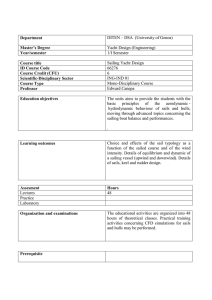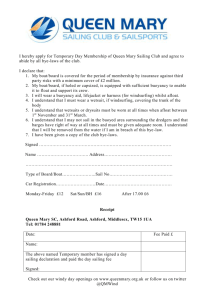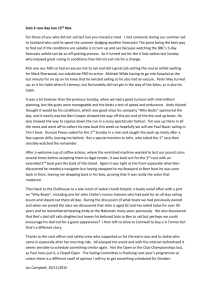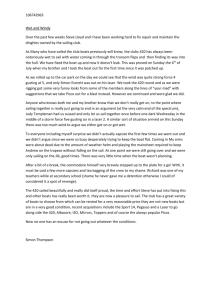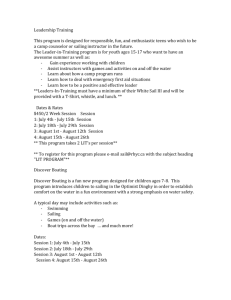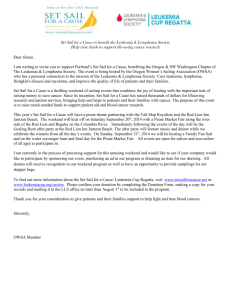`Weather Window....What`s That?`
advertisement
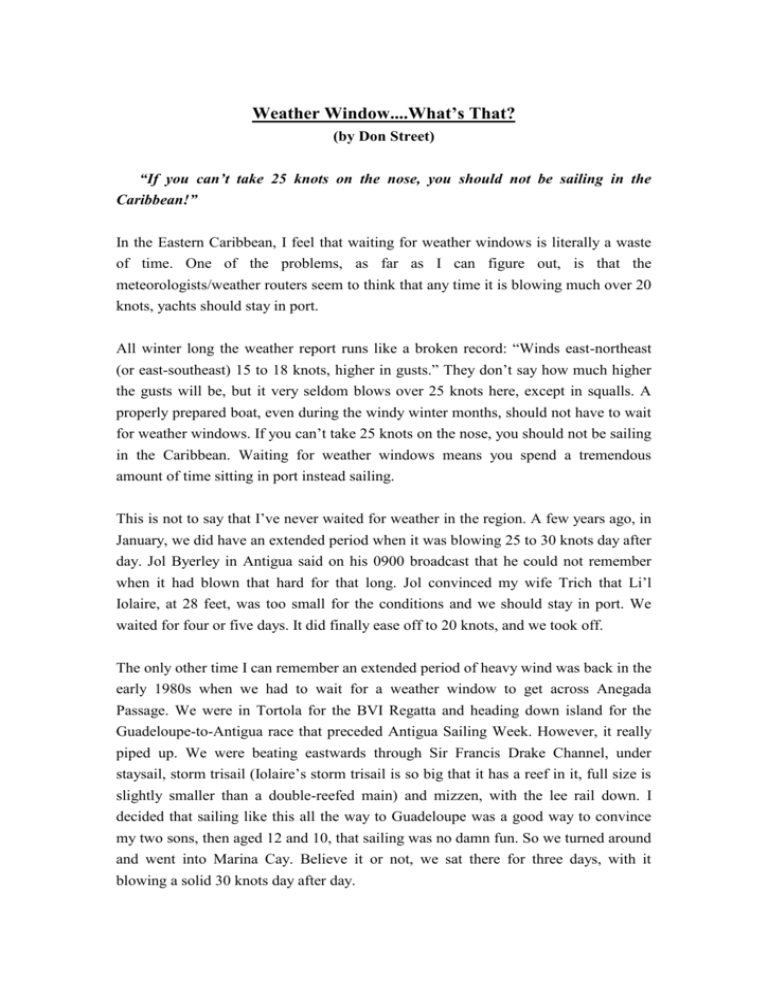
Weather Window....What’s That? (by Don Street) “If you can’t take 25 knots on the nose, you should not be sailing in the Caribbean!” In the Eastern Caribbean, I feel that waiting for weather windows is literally a waste of time. One of the problems, as far as I can figure out, is that the meteorologists/weather routers seem to think that any time it is blowing much over 20 knots, yachts should stay in port. All winter long the weather report runs like a broken record: “Winds east-northeast (or east-southeast) 15 to 18 knots, higher in gusts.” They don’t say how much higher the gusts will be, but it very seldom blows over 25 knots here, except in squalls. A properly prepared boat, even during the windy winter months, should not have to wait for weather windows. If you can’t take 25 knots on the nose, you should not be sailing in the Caribbean. Waiting for weather windows means you spend a tremendous amount of time sitting in port instead sailing. This is not to say that I’ve never waited for weather in the region. A few years ago, in January, we did have an extended period when it was blowing 25 to 30 knots day after day. Jol Byerley in Antigua said on his 0900 broadcast that he could not remember when it had blown that hard for that long. Jol convinced my wife Trich that Li’l Iolaire, at 28 feet, was too small for the conditions and we should stay in port. We waited for four or five days. It did finally ease off to 20 knots, and we took off. The only other time I can remember an extended period of heavy wind was back in the early 1980s when we had to wait for a weather window to get across Anegada Passage. We were in Tortola for the BVI Regatta and heading down island for the Guadeloupe-to-Antigua race that preceded Antigua Sailing Week. However, it really piped up. We were beating eastwards through Sir Francis Drake Channel, under staysail, storm trisail (Iolaire’s storm trisail is so big that it has a reef in it, full size is slightly smaller than a double-reefed main) and mizzen, with the lee rail down. I decided that sailing like this all the way to Guadeloupe was a good way to convince my two sons, then aged 12 and 10, that sailing was no damn fun. So we turned around and went into Marina Cay. Believe it or not, we sat there for three days, with it blowing a solid 30 knots day after day. As far as I can remember, in the 48 years I have been in the Caribbean those were the only two times I have waited for a weather window. Let’s look back at this past season: In early April I was in Grenada. Everyone was telling me to wait for a weather window as it was blowing hard, but I wanted to get to Antigua for the Classic Yacht Regatta and the arrival of my son Donald Street the Third (a.k.a. “DIII”), and I had numerous stops I needed to make en route. So I said to heck with the weather window. Normally I would leave the south coast of Grenada very early in the morning heading east, stopping halfway up the coast at Lascar Cove, Le Petit Trou or Requin Bay well before noon. We would have a relaxing afternoon in a quiet uncrowded harbour, then depart early the next morning before it is blowing and arrive at Grenada’s Sandy Island, again before noon. We would enjoy the solitude of Sandy Island, then continue on the third day to Carriacou leaving Sandy Island at the appropriate time to pick up the weather-going tide between there and Carriacou. This multi-stage approach makes a nice easy trip, rather than one long day of beating your brains out from the south coast of Grenada to Carriacou. (For a more detailed description of how to reach Carriacou via the east coast of Grenada, see the sailing directions on the back of the Imray-Iolaire chart B32.) However, in this case we decided to head up the west coast as it was the first sail of the season and I had a new crew on board who had never sailed with me, or on Li’l Iolaire. We discovered that our two stern anchors were badly fouled on mooring chains. Since I have blown my ears out and cannot dive more than seven or eight feet, we had a job clearing the anchors and did not depart until 0930. We headed up the west coast of Grenada under blade jib, reefed main and mizzen. We made very good progress until we ran into light airs between Gouyave and Victoria. The wind filled in and off we went. The ride was a bit bouncy to say the least, but Li’l Iolaire made short work of it. We passed Miss Irene Point on Union Island at 1900 and took another half an hour to coax Li’l Iolaire along in the light airs to the northeast corner of Chatham Bay, reaching the anchorage at 1930. We then sat down to a very nice dinner. The next morning we left at 0800. It was blowing “right pert” as they would say in Maine, so we had up blade jib, double-reefed main and mizzen. As we were passing between Union and Mayreau, we could see a squall coming and with an air of overconfidence I said, “Don’t worry Al, she’ll take a hell of a lot of wind with this sail combination.” However the squall hit us butt-end first and I had to quickly douse the main. We still had more than enough sail up with blade jib and mizzen. We flew along for about half an hour under this rig, then the wind eased and back up went the double-reefed main. Then, after another half an hour, we shook out the second reef. An hour later we had the full main up and had a glorious sail to Bequia, arriving at 1200. If we had listened to our friends’ advice in Grenada we would never have gone sailing. The Bequia to St. Lucia run was reported in my Sailing Directions column last month. I described how we missed the tide in the Bequia Channel. (You can’t hit them right all the time.) It was a real fight to get around the corner, but once we did we had an excellent sail. In St. Lucia, again, everyone was waiting for a weather window, but again, I was in a hurry to get up to Antigua. So, to hell with weather windows: we departed Rodney Bay under blade jib and mizzen. We decided to take a good look at the wind and sea conditions once clear of Pigeon Island before I made my decision as to setting the main and how many reefs to put in it. As we rounded Pigeon Island I tied a single reef and then double reef in the main, but did not bother hoisting it as we took off like a scalded cat. This time we had judged the tide correctly and it was lifting us beautifully to windward, plenty to pass to windward of Martinique, but the ride was a little bouncy with the wind against the tide. With only slightly cracked sheets we were able to sail well clear of the east coast of Martinique and pleasantly discovered when we reached the latitude of the southern end of the island that the tide was still under us. We sailed at a full 7 knots over the bottom all the way up to Presque Isle. After 18 hours I finally hoisted the double-reefed main, and we continued at hull speed. Eight hours later, as we passed between Guadeloupe and Desirade, we shook one reef out of the main and doused the mizzen so we were sailing with blade jib and reefed main. It was a glorious broad reach to Falmouth Harbour, Antigua, where we arrived at 0130 to pleasantly discover that — wonder of wonders — they had not only installed buoys, but had a buoy lit on Bishop’s Shoal. Thus, the night-time entrance into Falmouth Harbour was easy, except that it was impossible to pick up the range lights. However, we did not need them as we passed Bishop’s Shoal close aboard to starboard. Once we got into calm water, we rounded up, dropped the anchor, set the mizzen, set the anchor and poured a good stiff drink to celebrate sailing 210 miles in 34 hours in a 28-foot engineless yawl. Why wait for weather windows? There are, of course, a few things to remember about heavy weather in the Eastern Caribbean. Boats with a single-headsail rig should add a removable staysail stay, so that they can set up a staysail when expecting heavy weather. This way you can set up a staysail and roll up or take down the sail on the headstay. (Articles on this rig have been published in the mainstream yachting press over the years.). Further, ketches and yawls should not try to beat dead to windward under headsails and mizzen alone. All too often you see boats doing this, and the skippers will say they are just as fast under headsails and mizzen as they are with headsails and reefed main. But what they apparently don’t realise is that as soon as they douse the mainsail they lose the slot effect between the headsails and the main, thus increasing the tacking angle. This means your VMG (speed made good to windward) drops off drastically. If you are beating to windward and are tacking at 90 degrees, you sail 1.4 miles for every mile you make to windward. If you are tacking at 120 degrees you have to sail two miles to make one to windward. For that reason if a ketch or a yawl has to shorten sail to beat dead to windward, they should shorten down to staysail and reefed (or deep-reefed) main and get rid of the mizzen and whatever sail sets on the headstay. This way, everything is centered in the boat, the slot effect between the headsail and the main is preserved, and progress to windward will be much faster. IMPORTANT NOTE: Of course, in the Hurricane Season, weather windows are a serious consideration. During the Hurricane Season you should listen to the radio every morning for hurricane warnings (see “Selected Caribbean Shortwave Weather Reports” in the July 2003 issue of Compass). If a storm is predicted, get yourself south, below the hurricane belt. There is no longer any such thing as a safe hurricane hole anywhere in the Eastern Caribbean. Even if you are perfectly moored in the perfect anchorage, the “hurricane holes” are now so overcrowded that an improperly moored boat will inevitably drag down on top of your boat, most likely causing massive damage or total loss. Also, the subject of weather windows is very important when you are trying to head to the Caribbean from the East Coast of the States, or from England or Ireland through the Bay of Biscay. In those cases there are very definite reasons to wait for weather windows. I will discuss these weather windows in the October and November issues of the Caribbean Compass in two separate articles: • Getting to the Caribbean from the East Coast of the States • Getting to the Caribbean from Europe
